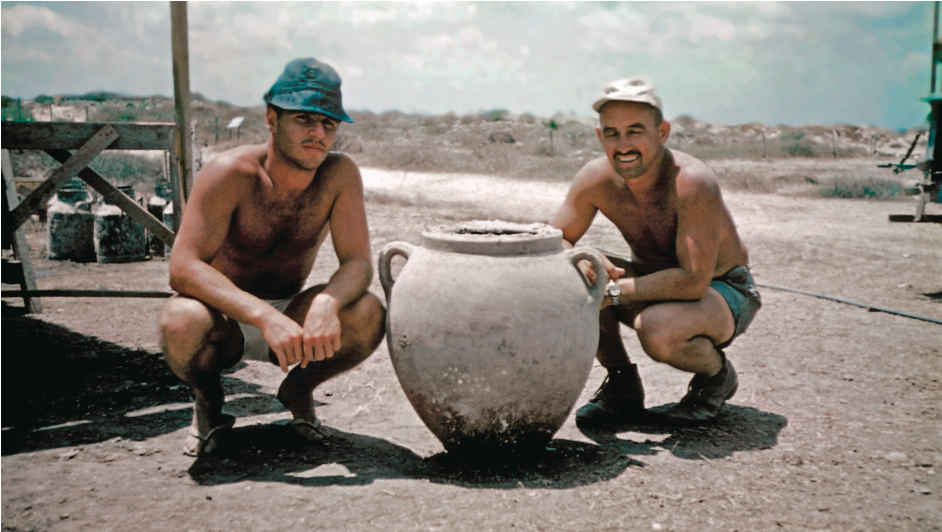 The “Rest of the Story”
The “Rest of the Story”
By: Olin Storvick and Marylinda Govaars
The ancient city of Caesarea Maritima, situated on the coast of modern day Israel, encompassed nearly 6000 acres at its zenith during the Roman/Byzantine eras. Archaeologists are slowly uncovering the archaeological evidence which dates as far back as the 3rd/2nd century BC. Among the earliest archaeologists to excavate at Caesarea was Michael Avi-Yonah of Hebrew University in Jerusalem. In 1956 Avi-Yonah led a small team (one graduate student and 10 workers) to investigate a presumed synagogue site north of the Crusader fortifications. Six years later, in 1962, Avi-Yonah returned with a much larger team (two assistant directors, four graduate students and 25 to 30 workers) to resume excavation of the synagogue site. Also, Avi-Yonah delegated his assistant director Avraham Negev to make four probes east of the synagogue site. The preliminary report on those probes was brief but tantalizing, for it mentioned mosaic floors, Coan amphorae, Megarian bowls, fragments of a chancel screen and fragments of an inscription mentioning the Twenty-Four Priestly Courses. No final report was written and no more information was available until recently.
The other assistant director on staff was an American, E. Jerry Vardaman, formerly of Southern Baptist Theological Seminary and later of Mississippi State University. Vardaman supervised the excavation site when Avi-Yonah and Negev were away plus he served as the daily supervisor for one of the four probes. After Vardaman’s death in, his widow graciously made available his papers which included his notes, sketches and photographs on those four probes. The probes were labeled “area B”, “area C”, “area D”, and “area F”. Our paper presents that information and correlates it with the earlier report by Avi-Yonah.

(From the BASOR article) Pithos. Hebrew University area B, 1962 (with T. Keats and Wm. Braudenberg). Vardaman photograph #28a. Courtesy of the E. Jerry Vardaman estate.
From 1975 to 1995 the Joint Expedition to Caesarea Maritima, under the direction of Robert J. Bull of Drew University in Madison, New Jersey, conducted excavations in this general area and some of that work impinged on the previous work of the Hebrew University. The Joint Expedition recorded 23 units in the general area with six units directly related to the Hebrew University probes; our paper outlines the relationship between the two excavations in two of the four probes mentioned. For example, the Hebrew University area B relates to the Joint Expedition Area G15, G16 and G25; mosaic floors and in situ storage jars to name two of the correlations. One of the relationships revealed is the stratigraphic excavation of the “Hellenistic structure” named by Hebrew University (Hebrew University area D relates to the Joint Expedition Area G18, G19 and G22). The “structure”, only two courses in height and in header-stretcher fashion, was thought to be part of the worn out town of Strato’s Tower on which Herod built Caesarea. According to the Jewish historian Josephus, in 22BC Herod the Great built a magnificent city on the coast of then Palestine and named it after the Roman emperor at the time, Caesar Augustus.
Our paper, of course, does not give the complete “rest of the story.” It does make a small but interesting contribution to our knowledge of the history of Caesarea Maritima.

Institutional Subscription Price (print, see below for online subscriptions): $270.00
For non-US subscriptions, add $30.00
Individuals may subscribe to the Institutional Subscription Price by printing and mailing a Subscription Form.
(Note: For individuals interested in receiving BASOR, please consider purchasing a membership that contains a subscription to BASOR rather than a BASOR Institutional Subscription. For more information on our memberships, click here.)
The Bulletin of the American Schools of Oriental Research (BASOR) is a leader among peer-reviewed academic journals of the ancient Near East. For nearly a century, since 1919 when William F. Albright originally founded it as the Bulletin of the American School of Oriental Research in Jerusalem, BASOR has served as a highly respected interdisciplinary English-language forum for scholars worldwide in subject areas such as archaeology, art, anthropology, archaeometry, bioarchaeology and archaeozoology, biblical studies, history, literature, philology, geography, and epigraphy. Published by the American Schools of Oriental Research (ASOR), the journal contains articles written by leading scholars and acknowledged experts in the ancient world which cover a geographical region from Israel and Canaan to ancient Anatolia, Mesopotamia, Cyprus, and Egypt and a chronological range from the Paleolithic period through Islamic times.
~~~
All content provided on this blog is for informational purposes only. The American Schools of Oriental Research (ASOR) makes no representations as to the accuracy or completeness of any information on this blog or found by following any link on this blog. ASOR will not be liable for any errors or omissions in this information. ASOR will not be liable for any losses, injuries, or damages from the display or use of this information. The opinions expressed by Bloggers and those providing comments are theirs alone, and do not reflect the opinions of ASOR or any employee thereof.
Pingback: Friday Varia and Quick Hits | The Archaeology of the Mediterranean World